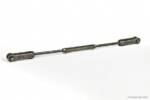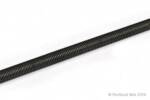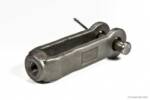Steven's FAQs

Turnbuckle Dimensions
How are turnbuckles measured?A turnbuckle body is designated by the diameter of the rod threading into it and the length of the take-up inside the turnbuckle rather than the overall length. For example, a 1” x 6” turnbuckle body has an overall length of 8⅞”, but has an opening or “window” measuring 6”. Common sizes available are 6”,... Read more

Stock Tie Rod Assemblies
Are stock tie rod assemblies available?Unfortunately not. Due to the custom nature of each assembly’s unique diameter, length, and right hand and left hand thread requirements, we do not have a way to inventory “standard” assemblies. Clevises also have several options per size including tap size, right or left hand threading, pin size, and grip which is the reason these... Read more

20′ All Thread
Are twenty foot lengths (20’) of all thread rod available?20’ lengths of all thread rod are not commercially available off the shelf and would have to be custom made to order. In most instances, all thread rod is cut to length and it is more economical to use more sticks of standard 12 foot and shorter sizes. If a 20 foot connection is needed,... Read more
Leveling Nuts
Can I use a full size nut as a leveling nut?In most situations you can. A leveling nut is a term that refers to the application of the nut rather than the physical dimensions of the nut. Many times they are called out as “jam” or “half” nuts because they can be cheaper, do not need to provide structural value, and are just used for leveling purposes. ... Read more
3/8″ F1554 Bolts
Can I order 3/8” diameter F1554 anchor bolts?No. In 2015, ASTM changed the diameter parameters from 1/4”- 4” to 1/2”- 4”; eliminating 1/4” and 3/8” diameters from the specification. This was in part due to the lack of material availability that had the test reports or traceability in these smaller diameters that conformed to the F1554 requirements. If your project requires F1554... Read more

Welding Clevises
Can I weld to a clevis?Technically you should not weld to a clevis which is made of C1035 steel and has a carbon content of approximately 0.35%, too high to be normally considered a weldable material. If the engineer has required welding to the clevis, then a special welding procedure should be followed that is outlined in AWS D1.1 or... Read more
Tie Rod Mounting Brackets
Does Portland Bolt manufacture the mounting brackets for tie rod assemblies?Unfortunately Portland Bolt does not have the capability to fabricate the wall mounts to which clevises attach. These fabricated lugs need to be designed by an engineer or architect to ensure they can withstand the loads applied to the tie rod assemblies. If you have a detailed drawing of the mounting brackets, we can have them... Read more
Fully Threaded A490s
Can ASTM A490 heavy hex structural bolts be fully threaded?2015 Update: Yes, ASTM A490 bolts can now be fully threaded. There is a supplemental provision in the F3125 specification that allows the bolt to be fully threaded as long as it is stamped with an “S”. The A490 specification starts at ½” diameter and stops at 1-1/2” diameter, and each diameter has its own specific thread length... Read more
Weathering Steel
Do A325-3 and A490-3 bolts rust?Yes, A325-3 and A490-3 are made from weathering steel containing copper, chromium, and nickel which induces the surface to form a heavy oxide coating that protects the base material from corroding any further. This brownish-red coating seals the material from corrosion much like other external coating options. These types of bolts are more often used... Read more
Cargo Containers
Does Portland Bolt load containers?Portland Bolt does not have the ability to load cargo containers for ocean freight. We have no experience in securing the contents inside so this will have to be done by a freight forwarder. We routinely load our shipments on a truck at our facility where they are sent to be loaded in a container... Read more

